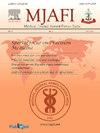前驱糖尿病风险测试在印度人群中筛查前驱糖尿病的外部验证
Q2 Medicine
引用次数: 0
摘要
背景:糖尿病前期风险测试(PRT)在西方人群中用于筛查糖尿病前期是有效的。然而,民族、种族、地理和其他生物学特征与前驱糖尿病的发展有关。关于PRT在印度人口中的外部有效性的文献缺乏。因此,本研究的目的是评估PRT在印度人群中筛查前驱糖尿病的外部有效性。方法研究对象522人,年龄在18 ~ 60岁之间。评估病史、体力活动水平和人体测量指标。通过空腹血糖和HbA1C水平诊断前驱糖尿病。采用特异性、敏感性、阳性预测值、阴性预测值、阳性似然比和阴性似然比对PRT进行外部验证。绘制接受者工作曲线以确定印度人的最佳临界值。结果PRT筛查印度人群糖尿病前期的敏感性为48.1%,特异性为95.5%,阳性预测值为66.1%,阴性预测值为90.9%。接受者工作曲线分析显示,印度人PRT的最佳截止时间在3左右。结论PRT在印度人群中识别糖尿病前期真阳性的敏感性为48.1%,可能不适用。但其特异性为95.5%,有助于鉴别真阴性。需要进一步研究修改PRT以适应印度的情况,使其更适合印度人口。本文章由计算机程序翻译,如有差异,请以英文原文为准。
External validation of Prediabetes Risk Test in Indian population for screening prediabetes
Background
Prediabetes Risk Test (PRT) has been found valid in the Western population for screening prediabetes. However, ethnicity, race, geographical and other biological characteristics have been linked to the development of prediabetes. There is a dearth of literature on the external validity of PRT in the Indian population. So, the objective of this study was to assess the external validity of the PRT in the Indian population for screening prediabetes.
Methods
The study contained 522 participants aged between 18 and 60 years. The medical history, physical activity level and anthropometric measures were assessed. Prediabetes was diagnosed using fasting blood sugar and HbA1C levels. External validation of PRT was performed using specificity, sensitivity, positive predictive value, negative predictive value, positive likelihood ratio and negative likelihood ratio. The receiver operating curve was plotted to identify the optimum cut-off value for Indians.
Results
The study found that the sensitivity of PRT was 48.1%, specificity 95.5%, positive predictive value 66.1% and negative predictive value 90.9% for screening prediabetes in the Indian population. Receiver operating curve analysis revealed that the optimum cut-off of PRT was around 3 for Indians.
Conclusion
The results showed that PRT might not be useful in the Indian population to identify the true positives of prediabetes as it has a sensitivity of 48.1%. However, it can be helpful to identify the true negatives as the specificity is 95.5%. Further study is required to modify PRT for the Indian context to make it more appropriate for the Indian population.
求助全文
通过发布文献求助,成功后即可免费获取论文全文。
去求助
来源期刊

Medical Journal Armed Forces India
Medicine-Medicine (all)
CiteScore
3.40
自引率
0.00%
发文量
206
期刊介绍:
This journal was conceived in 1945 as the Journal of Indian Army Medical Corps. Col DR Thapar was the first Editor who published it on behalf of Lt. Gen Gordon Wilson, the then Director of Medical Services in India. Over the years the journal has achieved various milestones. Presently it is published in Vancouver style, printed on offset, and has a distribution exceeding 5000 per issue. It is published in January, April, July and October each year.
 求助内容:
求助内容: 应助结果提醒方式:
应助结果提醒方式:


